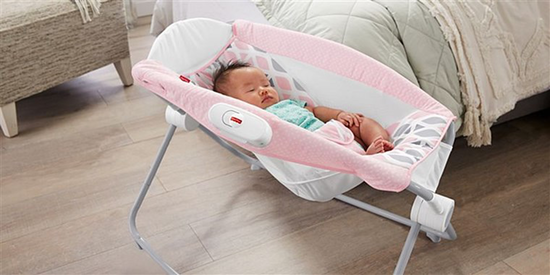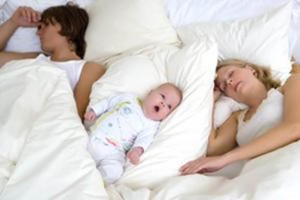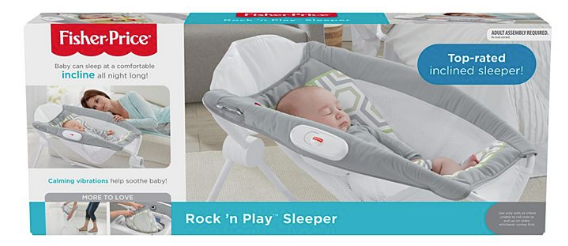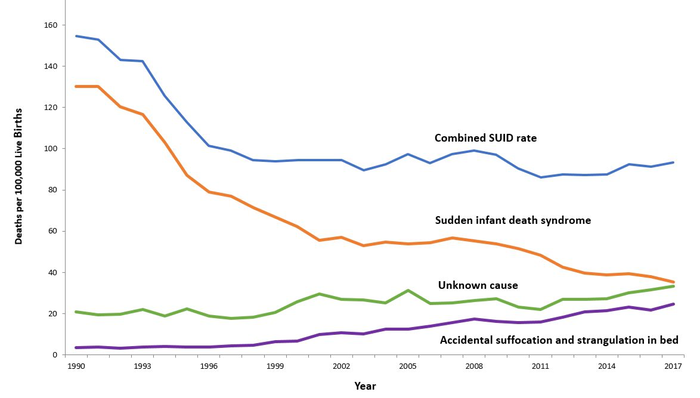The Rock N Play Recall
Over the course of several days earlier last month, the once-beloved Fisher Price Rock ‘n Play was exposed, denounced, and recalled.
The Rock ‘n Play was everywhere; now, it’s on its way out; soon it will be nowhere.

Here’s How it Went Down
In early April, Consumer Reports – an independent organization – released an analysis that linked the Rock ‘n Play to 32 infant deaths over the product’s 7-year lifespan, from 2011 through 2018.
Almost immediately, the American Academy of Pediatrics (AAP) released a statement urging parents to stop using the Rock ‘n Play and called for Fisher Price to recall the product. In a joint statement with the Consumer Product Safety Commission (CPSC), Fisher Price issued a warning: parents should stop using the Rock ‘n Play after babies turned 3 months.
Shortly thereafter, AAP president Dr. Kyle Yasuda cautioned that the Rock ‘n Play was “deadly and should be recalled immediately,” and Consumer Reports further noted that many of the related deaths had occurred within the “fourth trimester,” before babies even turned 3 months old. Facing additional pressure from medical experts, the public media and Consumer Reports, Fisher Price ultimately issued a total recall.
For those of us who’ve watched this unfold, it is… unnerving. This FP recall (and others close on its heels) have phased us — and for good reason.
I’ve spent years researching the history of sudden unexplained infant death for my book, Rest Uneasy: Sudden Infant Death Syndrome in Twentieth-Century America, and this episode strikes me as a curious and troubling extension of the history of unexpected infant deaths.
Troubling: from the start, this product directly conflicted with the AAP’s most basic guidelines for safe sleep: put babies to sleep alone, on their backs, on a flat, firm surface — the latter of these are the only pieces of advice in the history of modern pediatrics that have actually instigated a demonstrable reduction in infant sleeping fatalities.
Despite this knowledge, Fisher Price marketed the product as a safe place for babies to nap and sleep all night. Rock ‘n Play boxes depicted images of mothers clearly waking from sleep next to their babies, and advertised “naptime and nighttime settings” or “baby can sleep at a comfortable incline all night long!” Beyond this kind of slippery advertising, Fisher Price also asked for an expansion of regulatory stipulations on “inclined sleepers,” from a 5 to 10 percent incline. The CPSC agreed.
Troubling: The CPSC seemingly sanctioned this product when it was introduced, over the years, and even after the Consumer Reports exposé came out earlier last month.
Troubling: In 2015, when we (Lucie’s List editorial staff) set out to research this product — specifically with this concern in mind — we could find no data on infant deaths through the CPSC website or any other channels. Why was this information under lock and key? If lay people don’t have access to incident reports, how can we/they be expected to make informed decisions for the safety of their babies?
Troubling: There are tons of sleepers similar to the Rock ‘n Play. These are also slowly being recalled, but are there others that should also be included in this sweep?
Troubling: I use(d) them. In fact, most of us have.
Here’s the big question: who has the ultimate authority to decide what’s “safe” for our babies? Who is responsible for protecting consumers from unsafe pediatric products? Why didn’t Fisher Price immediately recall this item once these deaths started occurring? Why didn’t the CPSC act right away when they heard of these fatal incidents? Are parents left to their own devices and expected to read between the lines when it comes to product marketing?
Countless pediatricians have been railing against the Rock ‘n Play for years on the grounds that it conflicted with evidence-based sleep guidelines. One of the reasons the Rock ‘n Play was so revered was simply because babies sleep so well in them. The problem, according to many medical experts and evolutionary anthropologists, is that babies probably aren’t meant to sleep so well — natural selection has favored babies with adaptations that caused them to wake more frequently. In fact, the theory behind what may happen with SIDS is that many of the underlying risk factors (such as a brain abnormality) might actually cause babies to sleep too deeply — and stop breathing altogether.
With that in mind, we have yet to figure out how this recall will influence the broader issue of baby sleep safety.
For starters, sleep experts are wondering how the number of deaths associated with the Rock ‘n Play compares to other surfaces. After all, Sudden Unexpected Infant Death (SUID) naturally occurs at a certain rate — is it higher on the RNP than on other sleeping surfaces?
Secondly, experts are also concerned about whether desperate parents, devoid of products like the Rock ‘n Play, might resort to other frowned-upon, potentially unsafe sleep choices. Baby sleep consultant Alexis Dubief said on NPR: “We… know that infants die on all sleep surfaces. So what we are really trying to understand… is, what is the relative risk of the Rock ‘n Play compared to the crib, or, what often is the fallback position, [bed-sharing] with an adult?”
Conscientious, purposeful bed-sharing does not necessarily pose a risk, but Debief’s concern is particularly relevant when considering atypical bed-sharing (when families that don’t normally bed-share do bed-share), which is a clear risk factor for SUID (pillows, blankets and whatnot).

unplanned bed-sharing — the tired brain often makes bad decisions
Prominent anthropologist James McKenna, who runs the Mother-Baby Behavioral Sleep Laboratory at Notre Dame University, writes clearly about the realities of bed-sharing and how to practice it safely.
One thing I’ve learned from my research is that sleeping arrangements constitute only one factor in the SIDS equation, and as important as these decisions are, they are but one piece of a very convoluted puzzle. Researchers are exploring all kinds of potentially-relevant components, ranging from maternal smoking to carbon dioxide buildup in babies’ inner ears.
FYI: Sudden Infant Death Syndrome (SIDS) is one subcategory of Sudden Unexpected Infant Death (SUID), which also includes things like “accidental strangulation,” “accidental suffocation,” and other unknown or ambiguous causes of death among babies — many of which are coincidentally happen during or around sleep.
The Centers for Disease Control (CDC) collects data on this and you can read more about some of the statistics at the CDC’s website. The Rock ‘n Play deaths were likely categorized as SUID cases, variously, but that information isn’t widely available to the public (more on that shortly).
Unlike for other SUID, researchers still don’t know exactly what causes SIDS. They do know that it’s most common among babies one to four months old, is more likely among male babies, and more frequently affects lower-class and minority families. Researchers also know that some actions can reduce the risk of SIDS. We discuss the latest on safe sleep on our sleep page, and there are also numerous resources available, from the National Institute for Child Health and Human Development or the AAP, among others. If it’s any consolation, remember that even though SIDS is a leading cause of infant mortality, it is still fairly uncommon (the SIDS rate in 2017 was 35.4 deaths per 100,000 live births).
Unfortunately, there really isn’t any comprehensive data on SIDS (or SUID) by infant sleeping surface. Some studies have explored a specific comparison (such as a crib vs. bed-sharing), but there’s no way for us to know exactly how frequently SUID or SIDS occurs in, say, a crib vs. a Rock ‘n Play vs. a swing. This is part of the reason why it’s important to be familiar with the guidelines/recommendations and to implement them in a way that works for you and your family.
The story with the Rock ‘n Play is distinct, though, because the deaths associated with the product appear to have been completely preventable — a far cry from a typical SIDS loss, which are, by definition, unpreventable.
It seems to us that the CPSC has failed.
It had all the data, and it either failed to discern a problem or failed to act accordingly — or both. According to its website, the organization is specifically “charged with protecting the public from unreasonable risks of injury or death associated with the use of… products under the agency’s jurisdiction” — yet it took a third-party analysis (from Consumer Reports) combined with formal (the AAP) and informal (the public media) pressure for the CPSC to “do something” here.
Plus, Americans don’t have unlimited access to CPSC data. Parents who submit safety incident reports to the CPSC can make their submissions public (their accounts are chilling), but many of them send them privately to the organization.
So if the CPSC isn’t analyzing this data sufficiently or acting upon it, then who is?
After all, it’s unrealistic for us, as parents, to scrutinize data for every product we purchase. Not to mention, we don’t have all the data in the first place. Case in point: we called the CPSC to ask about getting the incident reports behind the Rock ‘n Play recall, and it’s a process. To gain access, you need to submit a Freedom of Information Act (FOIA) request to view records. Even to ascertain whether there have been any deaths associated with a product, you’d need to file a FOIA request. If your request is approved, it could be weeks, or longer, before you received the information requested.
More importantly, even if we had all this data, can we parents really interpret and assess it… for everything? That’s supposedly what the CPSC is for.
We’ll have to see what happens next, but hopefully the Rock ‘n Play recall will open the door to more conversations about how families can feel supported in choosing “what’s best” — and safest — for them. There’s still a ton of divide about where and how babies should be sleeping, and we’d love to see more open, honest conversations that take into account both evidence-based, safe-sleep advice and the realities of modern parenting.
We Asked the Experts
To that end, to help shed some light on sleep safety and gauge the significance that the Rock ‘n Play recall has had (and will have) on baby sleep safety, we talked to four different sleep and pediatric experts. Here’s who they are and what they had to say:
Devon Clement: Certified Postpartum Doula, PCD (DONA), baby sleep coach.
Leigh McMahon: Certified pediatric sleep consultant with 250-hour training at the Family Sleep Institute.
Patti J.: Night Nurse.
Mona Amin: Pediatrician, DO, FAAP.
1. Five million Fisher Price Rock n’ Play loungers have been recalled. To some parents, it’s the end of an era — they swore by this product to soothe their babies or help them sleep. But what do you think about the recall?
Devon Clement: Many babies just do not sleep when they’re flat on their backs on a safe sleeping surface. The Rock ‘n Play was a great way for babies to get some sleep, and recalling it because of the opportunity for misuse seems very shortsighted. But, this is the cycle of a great baby sleep product. The Nap Nanny was a similar unfortunate circumstance.
Leigh McMahon: “In our opinion, this recall was totally justified and long overdue. As safe sleep advocates, product recalls such as this are important because it helps us make the case that there are unsafe sleep products on the market. Even though a new mom’s BFF may swear that it was the only thing that worked for her baby, it doesn’t mean it’s ok to use, especially when it comes to sleep.
(…)The Rock ‘n Play doesn’t satisfy any of [the AAP safe sleep] guidelines and, in fact, flouts most of them — it’s inclined, it’s plush, and it’s a soft surface under the baby. While we 100% empathize with new parents whose babies struggle to sleep in their crib or bassinet, we’re happy that there is one less unsafe product in which babies could potentially suffocate or that could increase their risk of a SIDS-related death.”
2. What went wrong with the Rock n’ Play and what could Fisher Price have done differently?
Leigh McMahon: Every parent has heard countless stories of their friends’ babies sleeping well in the Rock ‘n Play and they turned out okay! But it’s important to remember that those babies were lucky, unlike the families of the 30 or more babies who weren’t so lucky. There isn’t a parent out there who would willingly put their child’s life in danger just to get a few extra hours of sleep. But there are a lot of parents out there who are too tired to research the pros and cons of every single baby product on the market. We believe this leaves the onus on the product manufacturers whose primary concern should always be safety.
What went wrong with the Rock ‘n Play was a profit-seeking manufacturer who took advantage of tired parents with questionable marketing practices…They capitalized on vulnerable parents who were desperately seeking sleep by using unclear, deceptive wording and misleading photos to promote their product.
To be clear, we absolutely don’t blame parents who purchased this item or put it on their registries; after all, Fisher Price marketed the Rock n’ Play as a sleeper and touted the effectiveness of the Rock n’ Play for helping fussy infants sleep better.
The deaths of the babies who died in a Rock n’ Play were preventable(…). Fisher Price should have rebranded the Rock ‘n Play as a safe place to put baby on only while awake and should have included noticeable and forceful warnings about not using it as a sleeper. Instead, they marketed it as a “sleeper” and spent a great deal of time and money getting around regulations that tried to block them from selling Rock ‘n Plays (Before Fisher Price’s Rock n’ Play Recall, Safety Fears and Dubious Marketing, NYT, April 19, 2019).
3. Is there something about this position that’s inherently dangerous and why?
Patti, night nurse: When you see pictures of a fetus in utero, she is curled up tightly, protected by the walls of the uterus, snuggled and secure within its comfy boundaries. Their lungs are not functioning at this point, so being curled up does not interfere with breathing. After birth, a baby is completely dependent on an open airway to breathe properly. When an infant who doesn’t have a lot of neck strength yet is in a semi-reclined position, her head is not supported, and it can fall forward or on the side. The airway can be occluded, and it can take only seconds for suffocation to occur.
When you see a baby in a Rock ‘n Play, she isn’t curled up, but she is in a semi-reclined position. (…)The Rock ‘n Play was designed to provide the snuggled feeling and secure boundaries similar to her/his uterine environment. An infant whose head falls forward or turned on its side will not have the strength in her neck to move or lift her head. In fact, the hammock seat is designed to “hug” the baby and makes it even harder to move. The seat of the Rock n’ Play can also be too deep for a smaller baby. This can make the baby “slouch,” causing the head to fall forward.
4. Have you ever recommended the Rock n’ Play as a sleep aid?
Devon Clement: I liked the Rock and Play a lot and recommended it often. Years ago, it was marketed for night sleep, but once concerns started coming out about the safety, I recommended clients only use it while the parents were awake and could supervise the baby to make sure nothing happened. It was especially useful for twins and multiples parents, to put one baby in to soothe while they fed or changed the other baby.
Mona Amin: I have never recommended it for a sleep aid. At visits, I always state that baby should be on her back in a crib for sleep with no bumpers, stuffed animals, or loose blankets. We know many over-tired parents are not doing this, but we have to be very clear about this for the safety of the child.
5. What does this recall mean for other semi-reclined products that are (or are not) marketed as sleep devices, yet babies tend to fall asleep in them?
Leigh McMahon: In our opinion, which is in line with the AAP recommendations, any product that isn’t labeled a crib or bassinet is potentially dangerous. Products that are cleverly marketed as “sleepers,” “nappers,” etc. are using those labels because they could not pass the stringent safety tests required to be considered a safe sleep product.
A quick Amazon search shows many popular products, like the SwaddleMe and Tiny Love 3-in-1, still being sold as nappers or sleepers that tout ways to get a baby to sleep better that are neither bassinets nor cribs nor Pack n’ Plays. With soft, plush surfaces, inclines and a slew of other unsafe components, none of these products meet the safe sleep guidelines. Buyer beware.
We would love to see all of the unsafe sleep products taken off the market. Until that happens, we urge that obvious and clear warnings about not letting a baby of any age sleep in these types of products be included on websites, packaging, in sponsored social media posts and on any site selling them.
7. What do you recommend parents look for in sleeping gear from now on? (Must-haves and red flags).
Devon Clement: The challenge of safe sleep is that it’s by nature not the best sleep – anything that helps a baby sleep deeply and comfortably is going to be more dangerous. I advise against using anything soft and cushy – I don’t know why the RnP is being recalled but the DockaTot is still available. Safe sleep products allow babies to be flat, with nothing that could potentially be a suffocation hazard near them at all.
Mona Amin: if you have to strap them into an item, it’s probably not intended for unattended sleep (i.e. car seat, Rock ‘n Play).
8. What alternative sleep products do you recommend for restful AND safe baby sleep?
Devon Clement: I like a good swaddle to help keep babies cozy and safe — my favorite is the Miracle Blanket! Only use this until baby is getting close to rolling, though. I also like a bassinet like the Baby Bjorn cradle that you can manually rock if baby is restless. White noise can be a big help too. I usually suggest the Homedics machine or the Lectrofan Micro.
Leigh McMahon: But the tough reality is that, at the moment, a crib with a firm mattress or bassinet/Pack n’ Play with the mattress it came with are the safest places for baby to sleep.
To make the transition to one of these spaces a little easier, put babies with their heads touching the top corner or with their feet touching the bottom part of the crib/bassinet/Pack n’ Play. Our instinct is to place them in the middle but placing them so that their body is touching something solid can really make them feel more cozy.
9. Products are great, but what are your tried and true tips to help sleep-deprived parents get their little one to sleep better?
Devon Clement: The absolute #1 best thing parents can do for better sleep is help their babies learn to fall asleep on their own, from completely awake, in their own sleeping space. It’s a skill that must be learned, and starting early is a great way to do it. When it’s time for sleep, swaddle baby up and put them down in their crib, and see what happens. They may just fall asleep for you!
Also, knowing how much sleep babies actually need and making sure they get it so they’re not overtired — it’s so much harder for them to sleep if they’re exhausted! I see many parents make the mistake of keeping babies awake during the day in the hope that they’ll sleep better at night but that’s the OPPOSITE of what you should do.
Patti: My #1 tip is that nearly every baby loves to be swaddled snuggly, very snuggly. Your baby may squirm or even fuss at first but will settle. Remember the uterus? My #2 tip is shushing, and it’s louder than you think shushing (see also: the Baby Shusher). I also tend to shush near their ear. My #3 tip is swaying. I may plant my feet and gently sway back and forth, add a little dip in the middle of the sway, or bounce on a ball.
Some babies need more vigorous movement and so I do what needs to be done but start to slow my pace when I notice less movement and a heavier, more relaxed feel to the baby’s body. My #4 tip is when laying baby in the crib or bassinet, I ALWAYS leave my hand on their chest with slight pressure to offer security and the sense of a boundary for several seconds before slowly removing it, like peeling a banana. Sucking is also helpful; babies love to suck!
Thank you to our guests to weighing in on this topic. Stay tuned for more as this situation develops. In the meantime, check out our current recommendations for Newborn Sleeping Arrangements.
— Brittany Cowgill, SIDS researcher and Sr. Editor
Bibliography:
https://www.newyorker.com/culture/culture-desk/the-life-and-death-of-a-wildly-popular-baby-sleeper
https://fisher-price.mattel.com/shop/en-us/fp/baby-sleepers/auto-rock-n-play-sleeper-dmj24
The post The Rock N Play Recall appeared first on Lucie's List.


For those in agriculture looking for top-notch tractors, tractor attachments serves as an excellent resource. They offer an extensive selection of bad boy tractor prices, all designed for outstanding durability and performance. If your needs include robust utility tractors, you can find several high-quality options. The Kubota L6060 specs represents a strong alternative for industry experts. Additionally, the kubota L2502 specs is celebrated for its excellent maneuverability and adaptability.
ReplyDelete